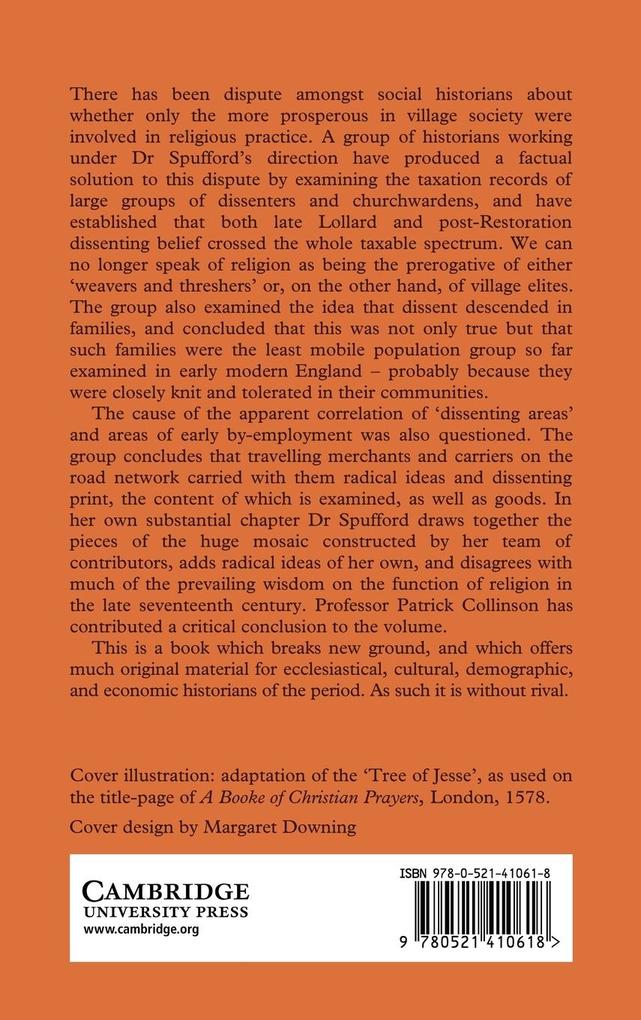
Zustellung: Mo, 23.06. - Do, 26.06.
Versand in 1-2 Wochen
VersandkostenfreiBestellen & in Filiale abholen:
There has been dispute amongst social historians about whether only the more prosperous in village society were involved in religious practice. A group of historians working under Dr. Spufford's direction have produced a factual solution to this dispute by examining the taxation records of large groups of dissenters and churchwardens, and have established that both late Lollard and post-Restoration dissenting belief crossed the whole taxable spectrum. We can no longer speak of religion as being the prerogative of either 'weavers and threshers' or, on the other hand, of village elites. The group also examined the idea that dissent descended in families, and concluded that this was not only true but that such families were the least mobile population group so far examined in early modern England - probably because they were closely knit and tolerated in their communities. The cause of the apparent correlation of 'dissenting areas' and areas of early by-employment was also questioned. The group concludes that travelling merchants and carriers on the road network carried with them radical ideas and dissenting print, the content of which is examined, as well as goods. In her own substantial chapter Dr. Spufford draws together the pieces of the huge mosaic constructed by her team of contributors, adds radical ideas of her own, and disagrees with much of the prevailing wisdom on the function of religion in the late seventeenth century. Professor Patrick Collinson has contributed a critical conclusion to the volume. This is a book which breaks new ground, and which offers much original material for ecclesiastical, cultural, demographic, and economic historians of the period.
Inhaltsverzeichnis
Preface; 1. The importance of religion in the sixteenth and seventeenth centuries Margaret Spufford; 2. The social and economic status of the later Lollards Derek Plumb; 3. A gathered church? Lollards and their society Derek Plumb; 4. The origins, function, and status of the office of churchwarden, with particular reference to the diocese of Ely Eric Carlson; 5. The gravestone of Thomas Lawrence revisited, or the Family of Love and the local community in Balsham, 1560-1630 Christopher Marsh; 6. Piety in the pedlar's pack: continuity and change, 1578-1630 Tessa Watt; 7. The mobility and descent of dissenters in the Chiltern Hundreds Michael Frearson, Nesta Evans and Peter Spufford; 8. The social and economic status of post-Restoration dissenters, 1660-1725 Bill Stevenson; 9. The social integration of post-Restoration dissenters, 1660-1725 Bill Stevenson; 10. Critical conclusion Patrick Collinson; Appendices.
Produktdetails
Erscheinungsdatum
11. April 2008
Sprache
englisch
Seitenanzahl
480
Herausgegeben von
Margaret Spufford
Verlag/Hersteller
Produktart
gebunden
Gewicht
924 g
Größe (L/B/H)
235/157/33 mm
ISBN
9780521410618
Entdecken Sie mehr
Pressestimmen
Review of the hardback: 'The World of Rural Dissenters is of central importance not only to historians of religion but to all who are interested in the nature of early modern societies and in how to investigate them. The group directed by Margaret Spufford have settled many an old argument and through their expertise and enthusiasm have produced a challenging agenda for new research.' David Hey, The Agricultural History Review
Bewertungen
0 Bewertungen
Es wurden noch keine Bewertungen abgegeben. Schreiben Sie die erste Bewertung zu "The World of Rural Dissenters, 1520 1725" und helfen Sie damit anderen bei der Kaufentscheidung.










